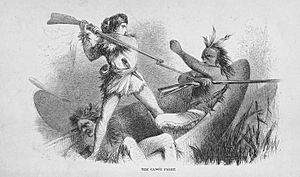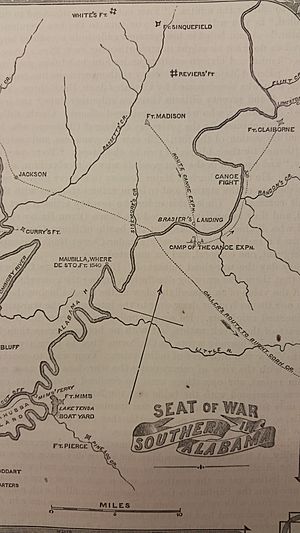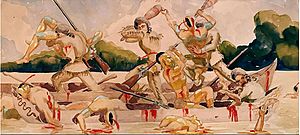Canoe Fight (Creek War) facts for kids
Quick facts for kids Canoe Fight |
|||||||
|---|---|---|---|---|---|---|---|
| Part of the Creek War | |||||||
 Samuel Dale and Creek warriors in the Canoe Fight |
|||||||
|
|||||||
| Belligerents | |||||||
| Creek | |||||||
| Commanders and leaders | |||||||
| unknown | |||||||
| Strength | |||||||
| 2 war-canoes | 1 war-canoe | ||||||
| Casualties and losses | |||||||
| 1 wounded 1 war-canoe damaged |
10 killed 1 war-canoe captured |
||||||
The Canoe Fight was a small but famous battle. It happened on November 12, 1813, during the Creek War. This fight was between soldiers from the Mississippi Territory and Native American warriors. Captain Samuel Dale led the soldiers. The warriors were part of a group called the Red Sticks. Most of the fighting took place in canoes on the Alabama River.
The soldiers won the fight. Only one of their men was hurt. This victory was not a huge turning point in the Creek War. However, the people who fought in it became very well known for their bravery. Many pictures have been made about the fight. Today, a historical marker stands near where the battle happened.
Contents
Why the Fight Happened
The Creek War was a conflict in the early 1800s. It involved the United States and different groups of Creek people. Some Creek groups, called White Sticks, supported the United States. They wanted to expand their government, the National Council. They also sold some Creek lands to pay off debts. These lands were in what is now Alabama and Georgia.
Other Creek groups, called Red Sticks, were against this. They felt the National Council was becoming too powerful. They believed decisions should be made by traditional Creek clans. The Red Sticks were also angry about their lands being sold. They did not like settlers moving onto their territory. Before the Creek War, these disagreements led to a civil war among the Creek people.
The United States worried the Red Sticks might join Great Britain in the War of 1812. Red Stick warriors sometimes attacked settlers who moved onto their lands. In response, people in the Mississippi Territory built forts. The U.S. military also took action against the Red Sticks.
After a terrible event called the Fort Mims massacre, local groups of soldiers were formed. These groups protected settlers in southern Alabama. They helped people gather their fall crops safely. But Red Stick warriors kept attacking settlers in the area.
Captain Samuel Dale had been hurt in an earlier fight. But he still offered to lead a group of soldiers. He had 30 volunteers from the Mississippi Territory. Another 40 volunteers joined from nearby areas. Their goal was to drive away the Red Stick warriors.
On November 11, Dale's group left Fort Madison. They traveled southeast toward the Alabama River. They crossed the river near modern Gainestown and set up camp. They got two canoes and then headed north along the river. Six to eight men stayed in the canoes. Jeremiah Austill was in charge of them. The rest of the soldiers marched along the eastern bank of the river.
Austill soon saw a canoe with Red Sticks coming down the river. The warriors quickly turned around. Then, Dale and his men ambushed another group of warriors. These warriors were preparing food near Randon's Creek. Dale's group killed one warrior. The volunteers started gathering the food and supplies the warriors left behind.
It was hard to march along the east bank. So, Dale told his men to cross to the west bank. All but twelve men crossed. Dale, Austill, and James Smith were among the twelve. They were getting some of the captured food ready. Suddenly, they heard the soldiers on the west bank shout a warning. They were surrounded by Creek warriors!
The Battle Begins
The twelve soldiers rushed to the river bank. But neither canoe had come back to pick them up. They also saw a canoe with eleven Red Stick warriors coming down the river. When the warriors saw the soldiers, they immediately turned their canoe around. For some reason, the warriors who had surrounded the soldiers on the east bank never attacked.
Two warriors from the canoe jumped into the river. They swam towards the bank. Smith shot and killed one of them.
Dale called for eight soldiers on the other side of the river. He wanted them to paddle over in the bigger canoe. But when these soldiers saw how many warriors were in the enemy canoe, they turned back.
The smaller canoe, paddled by a free Black man named Caesar, had reached the eastern shore. Dale decided to take this smaller canoe into the river. He wanted to meet the warriors. He asked Austill and Smith to go with him. Caesar paddled the canoe forward. All three soldiers tried to shoot at the warriors. But Austill's and Dale's guns did not fire. Their gun primers were wet. Smith's shot missed. Caesar kept paddling the canoe closer to the warriors.
Just before the canoes crashed into each other, the warrior chief reportedly shouted, "Now for it, Big Sam!" "Big Sam" was Dale's nickname among the Creek people.
Stories about the fight are a bit different. Most say that Austill was hit in the head by the chief's gun stock. After he recovered, Austill was hit again with a war club. Caesar held the two canoes together. Both sides hit each other with their rifles, using them like clubs. Austill used the war club that he had been attacked with to kill one of the warriors. At one point, Dale jumped into the warriors' canoe. He hit the warriors with his rifle. He also used a bayonet, which is a knife attached to a rifle.
All nine Red Stick warriors who stayed in their boat were killed. The four soldiers from Mississippi all survived. Only Austill had serious injuries. After the warriors' bodies were thrown into the river, the remaining warriors on the east bank started shooting at the small canoe. Dale, Austill, Smith, and Caesar reached the eight soldiers who were still on the east bank. They were able to get them safely to the west bank. The group then marched two more miles up the west bank. After that, they returned to Fort Madison.
What Happened After
The Canoe Fight was not a major turning point in the Creek War. But Samuel Dale became a hero in Alabama. People called him "The Daniel Boone of Alabama." He later served in the Alabama Legislature and became a general in the Alabama militia. He moved to Lauderdale County, Mississippi and died in Daleville, Mississippi.
Jeremiah Austill worked as a clerk for the Mobile County Court. He then moved to a large farm in Clarke County, where he died in 1879. James Smith continued to fight in other battles during the Creek War. He later moved to Mississippi before he died.
Stories about Caesar's life after the fight are different. Austill said Caesar stayed with a Creek man named Josiah Fisher until he died ten years later. But another writer, Henry S. Halbert, wrote that Caesar was sold to Dale. He said Caesar died in Kemper County, Mississippi in 1866.
Remembering the Fight
Two large paintings were made about the Canoe Fight. They were created during a government art project in the 1930s. John Kelly Fitzpatrick made a watercolor painting in 1938. This was his first idea for a possible painting in the Ozark, Alabama post office. John Augustus Walker was asked to paint several murals for Mobile's Old City Hall in 1936. His paintings showed Austill and Caesar during the fight.
The exact place where the fight happened is not known. It was near where Randon's Creek meets the Alabama River. The spot where warriors surrounded the twelve soldiers on the east bank has been found. It is on private land. A historical marker that tells about the Canoe Fight is located near Barlow Bend.
Images for kids






